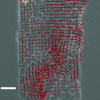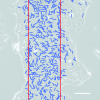Collective migration of an epithelial monolayer in response to a model wound
- PMID: 17905871
- PMCID: PMC2042149
- DOI: 10.1073/pnas.0705062104
Collective migration of an epithelial monolayer in response to a model wound
Abstract
Using an original microfabrication-based technique, we experimentally study situations in which a virgin surface is presented to a confluent epithelium with no damage made to the cells. Although inspired by wound-healing experiments, the situation is markedly different from classical scratch wounding because it focuses on the influence of the free surface and uncouples it from the other possible contributions such as cell damage and/or permeabilization. Dealing with Madin-Darby canine kidney cells on various surfaces, we found that a sudden release of the available surface is sufficient to trigger collective motility. This migration is independent of the proliferation of the cells that mainly takes place on the fraction of the surface initially covered. We find that this motility is characterized by a duality between collective and individual behaviors. On the one hand, the velocity fields within the monolayer are very long range and involve many cells in a coordinated way. On the other hand, we have identified very active "leader cells" that precede a small cohort and destabilize the border by a fingering instability. The sides of the fingers reveal a pluricellular actin "belt" that may be at the origin of a mechanical signaling between the leader and the followers. Experiments performed with autocrine cells constitutively expressing hepatocyte growth factor (HGF) or in the presence of exogenous HGF show a higher average velocity of the border and no leader.
Conflict of interest statement
The authors declare no conflict of interest.
Figures







Comment in
-
Collective cell migration patterns: follow the leader.Proc Natl Acad Sci U S A. 2007 Oct 9;104(41):15970-1. doi: 10.1073/pnas.0708037104. Epub 2007 Oct 3. Proc Natl Acad Sci U S A. 2007. PMID: 17913874 Free PMC article. No abstract available.
References
-
- Friedl P. Curr Opin Cell Biol. 2004;16:14–23. - PubMed
-
- Thiery J-P, Sleeman J. Nat Rev Mol Cell Biol. 2006;7:131–142. - PubMed
-
- Wood W, Jacinto A, Grose R, Gale J, Wilson C, Martin P. Nat Cell Biol. 2002;4:907–912. - PubMed
-
- Martin P, Parkhurst S. Development (Cambridge, UK) 2004;131:3021–3034. - PubMed
Publication types
MeSH terms
Substances
LinkOut - more resources
Full Text Sources
Other Literature Sources

